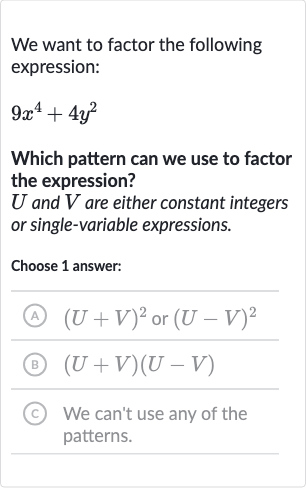AI tutor
Welcome to Bytelearn!
Let’s check out your problem:

We want to factor the following expression:Which pattern can we use to factor the expression? and are either constant integers or single-variable expressions.Choose answer:(A) or (B) (C) We can't use any of the patterns.
Full solution
Q. We want to factor the following expression:Which pattern can we use to factor the expression? and are either constant integers or single-variable expressions.Choose answer:(A) or (B) (C) We can't use any of the patterns.
- Identify Structure: Identify the structure of the given expression.The given expression is . We notice that both terms are perfect squares: and .
- Recognize Factoring Pattern: Recognize the factoring pattern. The expression resembles the sum of two squares, which can be written as , where and .
- Determine Factoring Possibility: Determine if there is a factoring pattern for the sum of squares.The sum of squares does not factor over the real numbers using the patterns , , or . These patterns apply to the difference of squares, not the sum of squares.
- Conclude Pattern Usage: Conclude which pattern, if any, can be used.Since the sum of squares does not have a factoring pattern over the real numbers, we cannot use any of the given patterns to factor the expression .
More problems from Compare linear and exponential growth
QuestionGet tutor help
QuestionGet tutor help
QuestionGet tutor help
QuestionGet tutor help
QuestionGet tutor help
QuestionGet tutor help
QuestionGet tutor help
QuestionGet tutor help
QuestionGet tutor help
